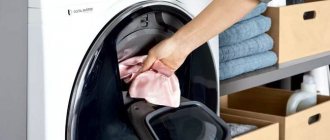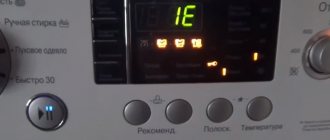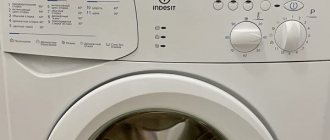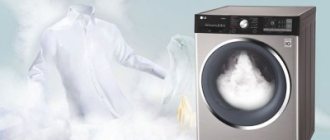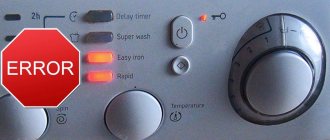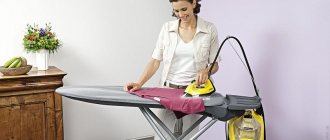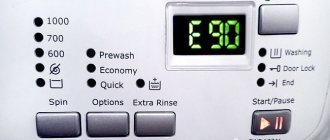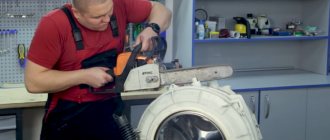Most modern people lead an active lifestyle. They are constantly on the move, constantly haunted by the noise of traffic, office equipment and other mechanisms. Therefore, at home I want to relax, enjoy peace and quiet. But even here it is not always possible to do this fully due to working household appliances.
The washing machine is especially noisy and restless; it not only makes unpleasant sounds when rinsing and spinning clothes, but also vibrates, trying to throw off the things folded on the lid and go for a walk around the kitchen or bathroom.
Why does the washing machine jump during the spin cycle?
The consequences of such behavior can be very serious - from an unpleasant conversation with neighbors to damage to the floor covering. Therefore, the vibration of the washing machine must be eliminated.
Anti-vibration stands for washing machine
Why do washing machines vibrate?
One of the main parts of the washing machine is the drum, into which the laundry is placed and water is poured. When the drum rotates, a centrifugal force arises, which spreads to the entire “washing machine”. Manufacturers for the most part try to compensate for vibration in some way - they install special counterweights, dampers and shock absorbers inside. But this does not completely solve the problem. Users often note that previously their machine worked quietly and did not vibrate, but over time it began to make noise, and its body began to tremble noticeably. This is usually due to wear and tear on the shock-absorbing devices.
If the noise becomes too annoying, you can try using anti-vibration stands (also called pads, supports, feet). These products can be especially useful for narrow washing machines. Often their manufacturers save space by partially abandoning control over balance and imbalance.
Features and principle of operation of anti-vibration stands
These stands prevent the washing machine from sliding on the floor, moving from its designated place and “jumping”, and reduce noise during washing and spinning. Their design is such that they are able to withstand an impressive weight - from 100 kilograms or more, which means they are suitable for any modern household model.
Anti-vibration supports are sold in sets of four pieces - in accordance with the number of legs. The diameter of one support is from 40 to 60 millimeters.
The outer surface of modern supports or stands is not smooth, but embossed, and this allows the machine to rest on them firmly and steadily. And the lower part of the stands has stiffening ribs. It is largely thanks to them that the noise and vibration emanating from the machine are so effectively dampened. And don’t be afraid that scratches and dents will appear on the floor - this is completely excluded.
Dimensions of a front-loading washing machine
Washing machines on the market can be divided into two main groups: front-loading and vertical loading. Further, each type is divided by size, drum volume and functionality.
Front-loading machines are among the most popular, and the model range of each brand is very wide. In such machines, the top panel can be used as a cabinet. Typically the drum holds up to 5 kg of laundry, but there are also models up to 10 kg.
Such units are equipped with an inspection hatch, which will be useful if an animal suddenly gets into the car or documents or a phone are found in your belongings. The hatch for loading laundry is located on the front panel - hence the name of this type of machine.
Devices with horizontal loading are placed so that there is enough space on the side of the front panel to open the hatch and freely fill the machine with laundry.
The diameters of the hatch range from 23 to 33 cm, the size of the hatch is important, since it is easier to put and take out laundry through a large hole. It is also important how wide the door opens - standard models have an opening angle of only 90 or 120 degrees, but there are models with an opening of 180 degrees.
Front-loading machines are available in full-size, narrow, compact and built-in types.
The width and depth of full-size ones are 60 cm, the height of the washing machine ranges from 85 to 90 cm. The choice of exactly this height is due to the fact that at this indicator there is less load on the arms and body of a person of average height, therefore a machine with a height of 85 c It can be installed next to the work surface, for example, in the kitchen. Loading laundry in full-size machines 5-7 kg.
Source: https://santehprice.ru/
Finding space in a small apartment for a full-size machine is not an easy task, which is why manufacturers of household appliances began to produce narrow washing machines. The dimensions of the washing machine are standard, with the exception of the depth - it is two times smaller - 32-40 cm depending on the model, load no more than 3.5-6 kg. Such machines will ideally fit into a small apartment, where every free centimeter counts.
How to choose the right product?
Nowadays, anti-vibration stands for washing machines are made mainly from the following materials:
- rubber;
- silicone
We recommend: Replacing water level sensors in washing machines after checking
Why these particular materials were chosen is not difficult to understand. Rubber is durable and wear-resistant. Stands made from it perfectly absorb vibration, in addition, rubber has anti-slip properties. It is also a fairly elastic material, so the stands can be pulled over the legs of the machine, even if it seems that they do not fit very well.
The same can be said about silicone. However, silicone pads, as practice shows, are slightly more expensive than rubber ones. However, many still choose products made from silicone, in particular because many false legs for washing machines made from this material have bizarre shapes, for example, the shape of the legs of some animals.
Anti-vibration mounts may also differ in color. Usually you can see black or white products in stores. But if you wish, you can also find, for example, transparent ones.
Advice
Some reputable companies that produce washing machines also make stands for them. For example, you can find products with the LG logo. But in this case, it is not necessary to take exactly the “native” stand; the vast majority of products available in retail sales are universal and will certainly suit your needs. There are even stands that can be used not only for washing machines, but also for refrigerators.
Interesting machine functions and washing programs
Modern washing machines are high-tech household appliances, capable of many things - from simulating hand washing to ozone treatment and easy ironing. Let's look at the most common and most original functions of washing machines.
Automatic Automatic washing machines are the most common; they do not require user intervention - only loading and removing laundry.
Polyautomatic The peculiarity of these types of machines is the need to participate in the washing process - moving the laundry from the drum to the centrifuge, filling it with water.
A washer-dryer is a type of machine that combines the functions of washing and drying. The drying function in such units is achieved through the supply of hot air, the source of which is a tubular electric heater.
Self-diagnosis is a functional feature of the latest generation machines. A machine with this function is equipped with a system that allows the unit to inform the user about various types of problems.
Bubble system. This technology involves supplying air through holes in the drum. Thanks to this, the washing powder foams and a large number of bubbles are formed, with the help of which some of the dirt is removed.
Dual boot function. Machines with a dual-loading function are equipped with two drums that can be used simultaneously in different modes for different types of laundry. One drum is located traditionally, the second is located in the compartment under the first and is located horizontally relative to the first. Double-loading machines are often larger in size - up to 120 cm in height, although you can also find standard sizes - 85 cm. Such devices have a maximum load capacity of 10.5 to 17 kg.
Start delay. Start delay. This function allows you to set up a washing program for a specific time - this is convenient if, for example, you want the washing to be done in your absence.
Sterilization - disinfection of clothes and bedding using hot air, getting rid of allergens, odors and bacteria.
Easy ironing - smoothing out creases using steam, this program is also suitable for delicate fabrics.
Night wash is designed for washing at night, in this program the noise level is reduced due to the low speed of rotation of the drum, often starting delayed start.
UV treatment and ozone treatment. Some machines have a function for disinfecting laundry using ultraviolet radiation or ozone.
Steam treatment or light ironing. When processing with steam, disinfection occurs, wrinkles are smoothed, and minor contaminants are removed. Some washing machines use this treatment directly during the standard program; this program is also suitable for delicate fabrics.
How to install stands yourself?
The stands can be installed in just a few minutes. First you need to check whether the legs of the machine itself are the same length. If this is not the case, then they need to be adjusted. And only after this should you carefully place stands under each leg. Once the installation is complete, you can put the washing machine back in place.
Such ease of installation determines another advantage of these products - if necessary, they can always be removed and replaced with new ones yourself.
Why is it not always advisable to buy coasters?
Before purchasing stands, it is worth checking whether the use of the described products will actually be appropriate. Owners of built-in appliances may encounter an obvious problem: after installing the stand, the machine will become slightly higher than other objects adjacent to it, and this will introduce a certain disharmony into the interior.
And in some cases, purchasing anti-vibration stands for washing machines is completely pointless. Sometimes equipment vibrates for reasons that these inexpensive things cannot correct.
- Washing machines vibrating and making loud noises during operation may be caused by uneven floors. This problem is not that uncommon, especially in older homes. The solution suggests itself: you just need to rearrange the machine so that the vibrations stop.
- Sometimes the machine starts to vibrate because it is on a wooden floor. Individual boards begin to move one by one (“shaking,” as people say) during the active phase of the washer’s operation, and this creates a very noticeable noise.
- The machine may also vibrate and make loud noises due to faulty bearings. But it is unlikely that you will be able to change them yourself; to do this you will need to disassemble the entire machine. Calling a specialist is the best way out in this case.
- The washing machine can also vibrate strongly because something is stuck in the space between the tank and the drum. You can try to pull it out through the hole in the heating element.
- If the machine is new, then it is worth checking whether the transport bolts have been unscrewed. They are used to secure the drum during transport. Their presence makes vibrations and noise very strong.
We recommend: The washing machine is noisy. How to solve a problem without a wizard
These are just some of the reasons and problems that can lead to vibrations. Therefore, before you buy anti-vibration feet for your assistant, it won’t hurt to call a household appliance repair specialist to inspect it.
Operating tips to reduce vibration
Do not overload the drum when washing. The suspension system is designed to work with a certain load. Excess will lead to excessive vibrations, and in the long term to premature failure of components.
Before starting, distribute things evenly around the circumference of the drum. There are models that can do this on their own, but still help them - artificial intelligence is not that smart yet.
If your machine is a top-loader, you can keep something heavy on it, such as a laundry basket. This will increase resistance to vibration.
Place the machine at a distance of at least 5 cm from the walls so that in an emergency it does not damage them or itself.
Anti-vibration mats - an alternative to stands
There is also a unique alternative to stands - an anti-vibration rubber mat. Mats are more expensive than coasters, but in any case, the price of these accessories is not too high.
There are special seals in the corners of the mats - these are where the machine's legs should be. Mats are made from the same materials as coasters, but they have a few special advantages.
- An anti-vibration mat under the washing machine makes its bottom more airtight.
- Such a mat does not require installation in principle - it is simply placed under the machine.
So, we can conclude that stands are a useful and inexpensive thing, but their purchase is not always justified. Therefore, you should first understand whether the machine is vibrating due to some kind of breakdown or malfunction, and check the evenness and quality of the floors in the place where the machine is located.
What parameters are taken into account when choosing
To begin, choose a convenient installation method: washing machines can be built-in or free-standing. Then take measurements of the space in which the machine will be installed. Subtract 2 cm from the measured parameters: width, depth and height - this margin is necessary to compensate for vibrations during washing if you choose a built-in model. Based on these parameters, you will determine the dimensions of the washing machine.
Next, determine the degree of automation of your future machine: automatic or semi-automatic. Thanks to the rapid development of technology, polyautomatic machines, although they are losing their popularity, still remain relevant for some users.
Source: https://ciscoexpo.ru/
After this, study the characteristics of the future assistant: the number of drum revolutions, the level of noise insulation, loading volume and additional functions.


